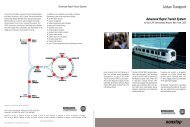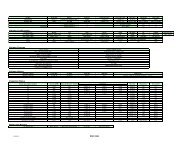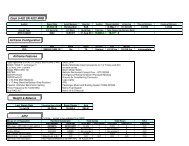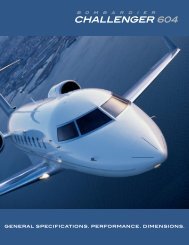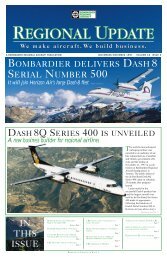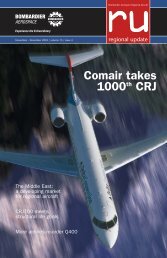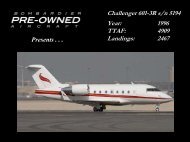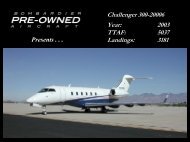BRJ-X design continues to evolve Q Series makes ... - Bombardier
BRJ-X design continues to evolve Q Series makes ... - Bombardier
BRJ-X design continues to evolve Q Series makes ... - Bombardier
You also want an ePaper? Increase the reach of your titles
YUMPU automatically turns print PDFs into web optimized ePapers that Google loves.
<strong>Bombardier</strong> Aerospace Regional Aircraft<br />
regional update<br />
j u n e - j u l y 9 9<br />
vol 12 - issue 3<br />
Q<strong>Series</strong> <strong>makes</strong> headway in China<br />
<strong>BRJ</strong>-X <strong>design</strong> <strong>continues</strong> <strong>to</strong> <strong>evolve</strong><br />
Flawless first flight & rollout<br />
for CRJ700 <strong>Series</strong>
Q400<br />
better than expected –<br />
Performance up, fuel flows down<br />
Flight testing of <strong>Bombardier</strong>’s<br />
next-generation Q400 has<br />
shown that the aircraft has<br />
surpassed its <strong>design</strong>ers’<br />
expectations in several key areas. Transport Canada<br />
certification was imminent as this issue of Regional<br />
Update went <strong>to</strong> press.<br />
The Q400 is faster. Predicted cruise speed was<br />
350 knots. The aircraft has flown at 360 knots at<br />
20,000 feet (6,096 m) under ISA conditions.<br />
Fuel flows in the Pratt & Whitney Canada<br />
PW150A engines are lower by 1.8% – 0.1284<br />
nautical miles per pound instead of the predicted<br />
0.1262 (ISA, 20,000 feet [6,096 m], 350 knots, 95%<br />
MTOW).<br />
Climb speed is greater. Time <strong>to</strong> 25,000 feet<br />
(7,620 m) is 16 minutes rather than the predicted<br />
17 minutes.<br />
Most flap extension speeds are lower.<br />
“We are extremely pleased at the results of flight<br />
testing,” said Steve Ridolfi, Vice-president and<br />
General Manager, Marketing and Operations at<br />
<strong>Bombardier</strong> Aerospace, Regional Aircraft. “We<br />
knew the Q400 would be a good airplane, but we<br />
didn’t realize how good it would be. Opera<strong>to</strong>rs will<br />
be getting a better Q400 than they thought, faster<br />
yet more economical.”<br />
The final – and most dramatic – of 16 major<br />
static tests on the Q400 airframe was completed in<br />
April, 1999 when the equivalent of 3 Gs of<br />
aerodynamic load was applied <strong>to</strong> the structure.<br />
With ultimate loads of 87,167 pounds (39,539 kg)<br />
applied <strong>to</strong> each wing and 86,074 pounds<br />
(39,043 kg) applied <strong>to</strong> the forward fuselage by<br />
49 hydraulic actua<strong>to</strong>rs, the maximum wingtip<br />
deflection produced was 6'1" (1.85 m). There was<br />
no damage <strong>to</strong> or permanent deformation of the<br />
structure.<br />
“Opera<strong>to</strong>rs will be getting<br />
a better Q400 than they<br />
thought, faster yet more<br />
economical.”<br />
In a 76-seat configuration, the Q400 delivers 10<br />
more seats than its main competi<strong>to</strong>r; at its<br />
maximum 78 seats, the Q400 carries 12 more<br />
passengers. Over a 200-nm (370 km) sec<strong>to</strong>r, the<br />
Q400 is 7.5 minutes faster, and over 500 nm<br />
(925 km) the Q400 is a substantial 19.5 minutes<br />
faster than its competi<strong>to</strong>r. And, thanks <strong>to</strong> the Q400<br />
aircraft’s Noise and Vibration Suppression (NVS)<br />
system, its passengers will arrive at their<br />
destination after a quiet, vibration-free flight.<br />
Translated in<strong>to</strong> productivity, the Q400 generates<br />
up <strong>to</strong> 32% more aircraft seat nautical miles per<br />
block hour over 200 nm and 37% more over<br />
500 nm.<br />
Profitability? The Q400 breaks even with just 22<br />
of its seats filled in a 74-seat configuration; the<br />
other 52 are pure profit.<br />
The Q400 is available in three basic versions for<br />
cost-effective payload capability, with maximum<br />
take-off weights ranging from 60,700 pounds<br />
(27,556 kg) <strong>to</strong> 63,750 pounds (28,917 kg) and<br />
maximum payloads ranging from 17,196 pounds<br />
(7,800 kg) <strong>to</strong> 18,696 pounds (8,480 kg).<br />
“What we have in the Q400,” said Mr. Ridolfi,<br />
“is next-generation technology where it was<br />
shown <strong>to</strong> be cost effective, high productivity,<br />
family commonality with other Q <strong>Series</strong> models,<br />
profitability in competitive low-yield environments<br />
and profitability in short haul, jet replacement<br />
markets.”<br />
And, the Q400 promises <strong>to</strong> have a long career,<br />
meeting the common Q <strong>Series</strong> structural <strong>design</strong><br />
criteria demanding a crack-free life of 40,000 flight<br />
hours or 80,000 flights, and an economic life of<br />
80,000 flight hours or 160,000 flights.<br />
Left, testing of the Q400 wing produced a maximum<br />
wingtip deflection of 6'1" (1.85 m) without damage <strong>to</strong><br />
or permanent deformation of the structure.<br />
Right and <strong>to</strong>p, the Q400 undergoing contaminated<br />
runway tests. It passed with flying colours.<br />
02<br />
june-july 99 • ru
Horizon Air ordered 15 Q400 aircraft and optioned an additional 15<br />
for its routes in the Western U.S. and Western Canada.<br />
Q400 launched<br />
in U.S.<br />
by Horizon Air<br />
“The Q400 has a winning combination: the speed and<br />
comfort of a jet and the economics of a turboprop.”<br />
Horizon Air of Seattle, Washing<strong>to</strong>n has become the North<br />
American launch cus<strong>to</strong>mer for <strong>Bombardier</strong> Aerospace’s 350-knot, 66- 78-<br />
seat Q400 turboprop airliner with a firm order for 15 and options on an<br />
additional 15. The aircraft will begin flying Horizon routes in the<br />
Northwest U.S. late in 2000.<br />
“The Q400 has a winning combination: the speed and comfort of a jet<br />
and the economics of a turboprop,” said George Bagley, Horizon Air’s<br />
President and CEO. “The Q400 aircraft’s 350-knot cruise speed means<br />
more productivity, and it features the Noise and Vibration Suppression<br />
(NVS) system which has proven <strong>to</strong> be so popular on our Q200 aircraft.”<br />
Horizon Air plans <strong>to</strong> replace older 37-seat Dash 8 <strong>Series</strong> 100 aircraft<br />
on some routes and complement its newer 37-seat Q200 aircraft on<br />
others, said Mr. Bagley.<br />
Horizon selected the high gross weight version of the Q400, along<br />
with the advanced symbology option of the Sextant Avionique avionics<br />
suite which incorporates vertical tape rather than round instruments.<br />
Horizon will also equip its Q400 aircraft with the Flight<br />
Dynamics, Inc. Head-up Guidance System (HGS) -- which it<br />
calls the “Fog Buster” -- for Cat. IIIa landing and take-off<br />
capability.<br />
With its HGS-equipped Q200 aircraft, Horizon has an industry-leading<br />
schedule reliability during the bad weather months of a Northwest U.S.<br />
winter.<br />
Said Robert Gillespie, President of <strong>Bombardier</strong> Aerospace, Regional<br />
Aircraft, “We look forward <strong>to</strong> having Horizon Air showcase our new Q400<br />
in the U.S. northwest and we are confident that the aircraft will help the<br />
airline increase its profitability. It has superb economics with the lowest<br />
seat-mile costs and the lowest breakeven load fac<strong>to</strong>r in its class.<br />
“Horizon Air is yet another example of a regional airline that requires<br />
both jet and turboprop equipment <strong>to</strong> efficiently and profitably serve its<br />
wide variety of markets,” said Mr. Gillespie. “The 25 new-generation,<br />
70-seat CRJ700 <strong>Series</strong> regional jets Horizon has ordered are the optimum<br />
aircraft for the airline’s current jet routes and for further expansion.<br />
The Q400 will fill a similar role on Horizon’s turboprop routes.”<br />
Founded in 1981, Horizon Air has grown <strong>to</strong> become the sixth-largest<br />
regional airline in the U.S., carrying more than 4.3 million passengers in<br />
1998. The carrier operates 550 daily flights serving 40 cities in the U.S.<br />
states of California, Idaho, Montana, Oregon and Washing<strong>to</strong>n as well as<br />
Western Canada. Horizon Air is a subsidiary of Alaska Air Group, Inc.<br />
june-july 99 • ru<br />
03
Inaugural flight<br />
for CRJ700 <strong>Series</strong><br />
The CRJ700 <strong>Series</strong>, first of the 70-seat class of<br />
regional jets, made its first flight on May 27,<br />
1999, the day before it was officially<br />
unveiled <strong>to</strong> an audience of more than 750<br />
cus<strong>to</strong>mers, guests, media and <strong>Bombardier</strong><br />
Aerospace executives and employees at Montreal.<br />
During the two-hour and 10-minute first flight<br />
of Serial Number 10001, which occurred one day<br />
before that originally scheduled a year ago, the<br />
aircraft reached an altitude of 15,000 feet (4,572 m)<br />
and an indicated airspeed of 230 knots (426 km/h).<br />
The aircraft’s maximum cruising altitude is<br />
41,000 feet (12,496 m) and maximum cruise<br />
speed is Mach 0.81.<br />
“The flight went extremely well,” said Craig<br />
Tylski, CRJ700 Project Pilot. “The aircraft was easy<br />
<strong>to</strong> handle, and provided a very stable platform.”<br />
Added John Holding, Executive Vice-president,<br />
Engineering and Product Development at<br />
<strong>Bombardier</strong> Aerospace, “There were no<br />
compromises made <strong>to</strong> achieve the first flight a day<br />
prior <strong>to</strong> official rollout. All flight test equipment<br />
and instrumentation was aboard and flight test data<br />
was telemetered <strong>to</strong> the ground in real time.”<br />
While the CRJ700 is clearly a stretched<br />
derivative of the 50-seat CRJ100 and CRJ200 <strong>Series</strong><br />
aircraft that began the regional jet revolution in<br />
the early 1990s, it is also clearly a secondgeneration<br />
product, building on the 1.7 million<br />
hours of CRJ experience.<br />
The most striking differences are in the<br />
passenger cabin, which has been <strong>to</strong>tally re-<strong>design</strong>ed<br />
for maximum comfort and convenience.<br />
Recon<strong>to</strong>ured and re-positioned overhead<br />
baggage bins provide comparable CRJ100 and 200<br />
amenities with additional clearances. The cabin<br />
windows have been enlarged and raised 4.5 inches<br />
(11.4 cm) <strong>to</strong> provide better sightlines and the floor<br />
has been lowered one inch (2.5 cm) <strong>to</strong> provide a<br />
full six feet, 2.25 inches (1.89 m) of headroom.<br />
Sidewalls have been re-<strong>design</strong>ed <strong>to</strong> provide an<br />
additional one inch (2.5 cm) of elbow room. The<br />
net effect is exceptional roominess.<br />
The CRJ700 sits four feet (1.2 m) higher on the<br />
ground than its smaller brothers. That, coupled<br />
04<br />
june-july 99 • ru
“We will have delivered 90 CRJ700 <strong>Series</strong><br />
aircraft before the only announced competi<strong>to</strong>r<br />
delivers its first one.”<br />
with the new window lines, gives the CRJ700 a<br />
distinctive “big airplane” look that appeals <strong>to</strong><br />
passengers.<br />
The lower floor does not impinge on the new<br />
belly baggage hold with its 109 ft. 3 (3.09 m 3 ) of<br />
s<strong>to</strong>wage capacity. The underfloor hold will give<br />
travelers the ability <strong>to</strong> have their bags s<strong>to</strong>wed as<br />
they board the aircraft, <strong>to</strong> be collected at planeside<br />
after landing, avoiding check-in counters and<br />
baggage carousels. This amenity can save travelers<br />
up <strong>to</strong> 45 minutes.<br />
The most striking<br />
differences are in the<br />
passenger cabin,<br />
which has been <strong>to</strong>tally<br />
re-<strong>design</strong>ed for<br />
maximum comfort and<br />
convenience.<br />
The CRJ700 <strong>Series</strong> has been <strong>design</strong>ed for<br />
maximum commonality with the CRJ100 and 200<br />
<strong>Series</strong> aircraft <strong>to</strong> achieve Common Crew<br />
Qualification (CCQ) for pilots with only minimal<br />
differences training, as well as common spares,<br />
ground support equipment and cus<strong>to</strong>mer support.<br />
The cockpits with their Collins ProLine IV avionics<br />
suites are identical, except for the leading-edge<br />
slats control in the CRJ700. The ailerons/roll<br />
control system and rudder controls are identical<br />
and the hydraulic system is similar. The CRJ700<br />
pitch control system is new because of the larger<br />
eleva<strong>to</strong>r and horizontal stabilizer. The leading edge<br />
slats provide improved field performance as well as<br />
a different attitude on approach.<br />
An analysis of a sample fleet of 10 50-seat<br />
CRJ100 or 200 <strong>Series</strong> and 10 CRJ700 <strong>Series</strong> shows<br />
that the commonality between the aircraft can<br />
represent a present value saving of $17.4 million in<br />
non-recurring and recurring costs.<br />
Addition of the CRJ700 <strong>Series</strong> <strong>to</strong> their existing<br />
CRJ fleets will give opera<strong>to</strong>rs the ability <strong>to</strong> meet<br />
growing capacity requirements on routes originally<br />
developed by the pioneering smaller CRJ aircraft,<br />
extend their hubs, bypass more congested hubs<br />
and open new point-<strong>to</strong>-point services.<br />
Coupled with the commonality savings are the<br />
economics of a 70-seat CRJ700 compared <strong>to</strong> the<br />
example of a 124-seat Boeing 737 on a 500-nm<br />
(925 km) sec<strong>to</strong>r. The CRJ700 breaks even with<br />
29.3 seats filled; the 737 requires 53.6 passengers<br />
<strong>to</strong> break even.<br />
<strong>Bombardier</strong> Aerospace, Regional Aircraft<br />
predicts a requirement for 1,500 regional jets in<br />
the 70-seat class over the next 20 years.<br />
“We’re proud <strong>to</strong> be first <strong>to</strong> the market with our<br />
CRJ700,” said Robert Gillespie, President of<br />
<strong>Bombardier</strong> Aerospace, Regional Aircraft. “In fact, we<br />
will have delivered 90 CRJ700 <strong>Series</strong> aircraft before<br />
the only announced competi<strong>to</strong>r delivers its first one.”<br />
Commonality between<br />
the aircraft can<br />
represent a present value<br />
saving of $17.4 million in<br />
non-recurring and<br />
recurring costs.<br />
As of June 14, 1999, the CRJ700 <strong>Series</strong> had<br />
attracted firm orders for 96 aircraft from six<br />
airlines and options on an additional 165 aircraft.<br />
Announced cus<strong>to</strong>mers include BRIT Air of France,<br />
Lufthansa CityLine of Germany, and American<br />
Eagle, Atlantic Southeast Airlines, COMAIR and<br />
Horizon Air of the U.S.<br />
THE GLOBE AND MAIL<br />
THE OTTAWA CITIZEN<br />
NEWS FLASH<br />
New CRJ<br />
pre-flight,<br />
delivery<br />
facility<br />
<strong>Bombardier</strong> Aerospace will build a new<br />
$30 million (Cdn.) CRJ <strong>Series</strong> aircraft preflight<br />
and delivery centre adjacent <strong>to</strong> the<br />
company’s manufacturing facility at<br />
Montreal’s Dorval International Airport.<br />
Scheduled for completion in the spring of<br />
2000, the 18,580 m 2 (200,000 ft. 2 ) facility<br />
will provide space for up <strong>to</strong> 18 CRJ and<br />
Challenger 604 business jet aircraft at a time.<br />
june-july 99 • ru<br />
05
<strong>BRJ</strong>-X<br />
<strong>continues</strong> <strong>to</strong> <strong>evolve</strong><br />
Configuration of <strong>Bombardier</strong> Aerospace’s proposed 90- 110-seat<br />
<strong>BRJ</strong>-X regional twinjet airliner has been further refined based on input from<br />
the Airline Advisory Council and ongoing engineering <strong>design</strong> activities.<br />
The new configuration was presented <strong>to</strong> the Council at its second meeting<br />
in Montreal on May 27, 1999. It includes fly-by-wire controls as baseline and a<br />
revised wing planform <strong>to</strong> reduce weight. A Canadair Challenger business jet<br />
equipped with Active Control Technology (ACT) began its flight test program<br />
early in June, 1999 <strong>to</strong> develop hands-on FBW expertise. The 90-seat <strong>BRJ</strong>-X-90<br />
has been structurally optimized <strong>to</strong> offer better economics <strong>to</strong> the airlines and will<br />
share geometric similarity and common systems with the 110-seat <strong>BRJ</strong>-X-110.<br />
A partial cabin mockup<br />
of the <strong>BRJ</strong>-X with business<br />
and economy class<br />
seating, galley, lava<strong>to</strong>ry<br />
and other passenger<br />
amenities was unveiled at<br />
the Paris Air Show in<br />
June, 1999.<br />
Other baseline aircraft <strong>design</strong> parameters:<br />
• Typical passenger capacity in an all-economy configuration will be 95 and<br />
115 at 32-inch (81.3 cm) seat pitch for the <strong>BRJ</strong>-X-90 and <strong>BRJ</strong>-X-110 respectively.<br />
A typical two-class configuration could include basic versions of 88 and 108<br />
seats, both with eight business class seats. A partial cabin mock-up with business<br />
and economy class seating at 40-inch (101.6 cm) and 32-inch (81.3 cm)<br />
respectively was displayed at the 1999 Paris Air Show.<br />
• The aircraft is being <strong>design</strong>ed for jet bridges.<br />
• Cat. II landing capability is standard and Cat. IIIa will be optional.<br />
Both au<strong>to</strong>land and a Head-up Guidance System are being evaluated for<br />
Cat. IIIa capability.<br />
The <strong>BRJ</strong>-X-90 will be 102.2 feet (31.2 m) in overall length while the <strong>BRJ</strong>-X-<br />
110 will be 113.9 feet (34.7 m) long. They will have a common wing of 89.5 feet<br />
(27.3 m) in span, an area of 960 ft. 2 (89.2 m 2 ) with a sweep of 25.6 degrees.<br />
Height <strong>to</strong> the tip of the tail of both models is 35 feet, 3 inches (10.7 m).<br />
WEIGHTS <strong>BRJ</strong>-X-90 <strong>BRJ</strong>-X-110<br />
(lb) (kg) (lb) (kg)<br />
Max. Take-off 106,500 48,300 116,800 52,980<br />
Max. Landing 92,600 42,000 101,600 46,080<br />
Max. Zero fuel 87,300 35,600 96,800 43,900<br />
Operating Empty 61,300 27,800 64,800 29,400<br />
Max. Fuel 28,700 13,000 28,700 13,000<br />
Max. Payload 26,000 11,800 32,000 14,500<br />
Performance objectives for the <strong>BRJ</strong>-X-90 and <strong>BRJ</strong>-X-110 include a maximum<br />
certified altitude of 39,000 feet (11,887 m), normal cruise speed of Mach 0.80<br />
and range at normal cruise speed of 1,800 nm (3,337 km). High speed cruise<br />
will be Mach 0.82.<br />
While the propulsion system supplier has not yet been selected, the <strong>BRJ</strong>-X-90<br />
engines would be of approximately 19,000 pounds of thrust (84.52 kN), while<br />
the <strong>BRJ</strong>-X-110 engines would be of about 20,000 pounds of thrust (88.96 kN).<br />
The engines would meet or exceed all noise and emission requirements.<br />
The 90-seat <strong>BRJ</strong>-X-90 has been structurally<br />
optimized <strong>to</strong> offer better economics <strong>to</strong> the airlines<br />
and will share geometric similarity and common<br />
systems with the 110-seat <strong>BRJ</strong>-X-110.<br />
Computer-generated virtual reality technology is being used <strong>to</strong> assist in the<br />
interior <strong>design</strong> of the <strong>BRJ</strong>-X; similar human modeling is being used for<br />
maintenance assessment. With this technology, “passengers” can move about<br />
the cabin, for example, while “flight attendants” can work in the galleys or<br />
“maintenance technicians” can move in<strong>to</strong> the avionics bay and remove and<br />
replace avionics modules.<br />
Launch approval is targeted for the second quarter of 2000. By that time, all<br />
program partners will have been selected and the Joint Definition and Detailed<br />
Design Phases will begin, leading <strong>to</strong> rollout in the second quarter of 2002, the<br />
flight test program, and type certification late in 2003.<br />
“Input from the Airline Advisory Council confirms our belief that there is a<br />
clear requirement for aircraft of the <strong>BRJ</strong>-X capacity and performance in the<br />
fleets of the world’s regional airlines,” said Robert Gillespie, President of<br />
<strong>Bombardier</strong> Aerospace, Regional Aircraft. “Our aim is <strong>to</strong> provide the most<br />
efficient, economical and flexible product <strong>to</strong> meet that requirement.”<br />
Maximum<br />
Takeoff<br />
Weight<br />
(1000 lbs)<br />
Aircraft Take-off Weight vs. Seating Capacity<br />
225<br />
200<br />
175<br />
150<br />
125<br />
100<br />
75<br />
50<br />
New Market Niche<br />
Requiring Suitable<br />
Product<br />
ERJ-135<br />
CRJ-200<br />
ERJ-145<br />
CRJ-700<br />
<strong>BRJ</strong>-X<br />
717-200<br />
Regional Aircraft<br />
737-600<br />
A320<br />
A319<br />
A318 737-700<br />
737-800<br />
757-200<br />
A321<br />
Mainline<br />
Boeing & Airbus<br />
Products<br />
737-900<br />
25<br />
25 50 75 100 125 150 175 200 225<br />
06<br />
june-july 99 • ru<br />
Seat Capacity - Single Class
Q400<br />
breakthrough in<br />
China<br />
Changan Airlines is based in the region where<br />
hundreds of terra cotta soldier figures were<br />
discovered several years ago.<br />
<strong>Bombardier</strong> Aerospace’s new Q400<br />
airliner gained a foothold in the important Asian<br />
market in April, 1999 with a firm order for three of<br />
the 350-knot aircraft from Changan Airlines of The<br />
People’s Republic of China.<br />
The transaction was finalized with a contract<br />
signing by She Yining, President of Changan<br />
Airlines, Bai Zhijian, President of China Aviation<br />
Supplies Corporation and <strong>Bombardier</strong> officials.<br />
Sergio Marchi, Canada’s Minister of International<br />
Trade and Zeng Peiyan, Minister of the Republic’s<br />
State Development and Planning Committee, were<br />
present at the signing because of its importance <strong>to</strong><br />
the further development of trade between the two<br />
nations.<br />
According <strong>to</strong> Mr. She, China will put a greater<br />
focus on regional transport and there will be<br />
continuous traffic growth with increasing<br />
passenger demand. There is a need for new, higher<br />
capacity aircraft offering greater reliability and<br />
comfort. As an airline, Changan also wants<br />
economical operating costs. The Q400 was selected<br />
based on these considerations, said Mr. She.<br />
Changan Airlines was established only recently<br />
but has seen continuous growth. During its first full<br />
year of operations in 1993, it carried about 15,000<br />
passengers and generated the equivalent of about<br />
$282,500 U.S. in revenues on five routes. In 1997, it<br />
carried 132,550 passengers and earned revenues of<br />
more than $7 million on 25 routes.<br />
Based at Xian in Shaanxi Province in central<br />
China, Changan Airlines currently operates five<br />
Chinese-built 50-passenger Y7-100 and two recentlydeveloped,<br />
56-seat Y7-200A aircraft. It plans <strong>to</strong> use<br />
its 78-passenger Q400 aircraft <strong>to</strong> expand its route<br />
network. Planned utilization of the Q400 aircraft is<br />
about 2,400 hours a year.<br />
june-july 99 • ru<br />
07
CRJ Q <strong>Series</strong><br />
deliveries in April and May 1999<br />
Eight airlines <strong>to</strong>ok delivery of 18 <strong>Bombardier</strong> Aerospace regional jet and<br />
turboprop aircraft between April 1 and May 31, 1999.<br />
Air Lit<strong>to</strong>ral of France accepted the 16th CRJ100 <strong>Series</strong> regional jet from its firm<br />
order for 19.<br />
Atlantic Coast Airlines of the U.S. <strong>to</strong>ok delivery of four CRJ200 <strong>Series</strong> jets,<br />
bringing its fleet <strong>to</strong>tal <strong>to</strong> 20. The airline has firm orders for 43.<br />
Delta Connection Atlantic Southeast Airlines, which has ordered 45 CRJ200<br />
<strong>Series</strong> regional jets, <strong>to</strong>ok delivery of its 21st and 22nd aircraft.<br />
Another Delta Connection, COMAIR, received numbers 76, 77 and 78 from its<br />
firm order for 110 CRJ100 <strong>Series</strong>. COMAIR is the world’s largest CRJ fleet opera<strong>to</strong>r.<br />
Mesa Airlines has ordered 32 CRJ200 <strong>Series</strong> aircraft and <strong>to</strong>ok delivery of<br />
numbers 24 and 25.<br />
The 12th of firm orders for 26 CRJ200 <strong>Series</strong> aircraft was delivered <strong>to</strong> Midway<br />
Airlines.<br />
UNI Air of Taiwan accepted the Q200 turboprop it had on order. UNI will begin<br />
taking deliveries this fall on the six 350-knot, 78-seat Q400 aircraft it has on order.<br />
US Airways Express, the largest Dash 8 and Q <strong>Series</strong> opera<strong>to</strong>r in the world, <strong>to</strong>ok<br />
delivery of four Q200 aircraft from its recent firm order for nine. One was delivered<br />
previously.<br />
Q <strong>Series</strong> Dash 8 / Dash 8 Facts and Figures<br />
Sales (June 2, 1999) Delivered Backlog Total<br />
<strong>Series</strong> 100 296 3 299<br />
<strong>Series</strong> 200 76 12 88<br />
<strong>Series</strong> 300 150 11 161<br />
<strong>Series</strong> 400 0 42 42<br />
Program <strong>to</strong>tal 522 68 590<br />
Q <strong>Series</strong> Dash 8 / Dash 8 Fleet Statistics<br />
Aircraft in service 511 As of March 1999<br />
Average flight time 48 mins. As of March 1999<br />
Average annual utilization 2,225 flight hours As of March 1999<br />
Highest annual utilization 3,300 flight hours As of March 1999<br />
Fleet <strong>to</strong>tal time 8,211,540 flight hours As of March 1999<br />
Fleet <strong>to</strong>tal cycles 10,001,019 flight cycles As of March 1999<br />
Dispatch reliability rate 99.0% 12-month average <strong>to</strong> Dec. 1998<br />
Schedule completion rate 99.3% 12-month average <strong>to</strong> Dec. 1998<br />
CRJ <strong>Series</strong> Facts and Figures<br />
Sales (June 2, 1999) Delivered Backlog Total<br />
100/200 <strong>Series</strong> 301 238 539<br />
700 <strong>Series</strong> 0 96 96<br />
Corporate variants 12 0 12<br />
Program <strong>to</strong>tal 313 334 647<br />
CRJ Fleet Statistics<br />
Aircraft in service 297 As of March 1999<br />
Average flight time 1.1 hours As of March 1999<br />
Average annual utilization 2,418 hours As of March 1999<br />
Highest annual utilization 3,754 hours As of March 1999<br />
Fleet <strong>to</strong>tal time* 1,680,877 hours As of March 1999<br />
Total fleet cycles* 1,505,091 As of March 1999<br />
Dispatch reliability 98.8% 12-month average <strong>to</strong> Jan. 1999<br />
Schedule completion rate 99.3% 12-month average <strong>to</strong> Jan. 1999<br />
regional update<br />
REGIONAL UPDATE is published by<br />
<strong>Bombardier</strong> Aerospace Regional Aircraft,<br />
Garratt Boulevard, Downsview, Ontario, Canada M3K 1Y5<br />
Tel: (416) 375-4027 Fax: (416) 375-4540<br />
President, Robert D. Gillespie<br />
Senior Vice-president, Sales, John Giraudy<br />
Vice-president Sales, Asia/Pacific, James Dailly<br />
Vice-president Sales, International, John Howarth<br />
Vice-president Sales, The Americas, Ric Allison<br />
Vice-president and General Manager,<br />
Marketing and Operations, Steve Ridolfi<br />
Copyright © <strong>Bombardier</strong> Inc. 1999<br />
Printed in Canada<br />
Internet address: www.aero.bombardier.com<br />
Information, technical data and performance figures in this publication are subject <strong>to</strong> change without notice.<br />
This publication does not intend <strong>to</strong> convey any guarantees or warranties. Any guarantees or warranties on any subject<br />
are extended <strong>to</strong> cus<strong>to</strong>mers only as may be provided in their purchase agreements.<br />
Articles in Regional Update may be reproduced without permission, providing that acknowledgment is given <strong>to</strong><br />
<strong>Bombardier</strong> Aerospace’s Regional Update.<br />
* CRJ fleet <strong>to</strong>tal time and cycles do not include corporate/business opera<strong>to</strong>rs.<br />
Utilization based on schedule data.<br />
08<br />
june-july 99 • ru





